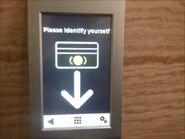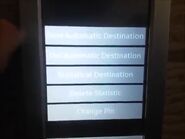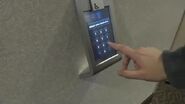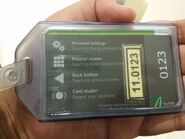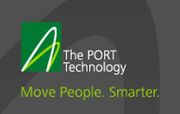
Schindler PORT (PORT stands for Personal Occupant Requirement Terminal), or officially known as The PORT Technology is a destination dispatch system invented by Schindler, and it is the successor of both Schindler Miconic 10 and Schindler ID.
History
Schindler was the first elevator company to pioneered destination dispatch elevator system. They launched the Miconic 10 system in 1992 as the first practical destination control system in the world. Then in 2000, they launched a second generation of destination control system called SchindlerID. These two successful systems led to the creation of a third generation system; the Personal Occupant Requirement Terminal, or simply known as PORT was launched in 2009 as a successor of both Miconic 10 and SchindlerID.
Overview
Schindler PORT is a destination control system powered by intelligent software that runs on a highly advanced algorithm that continuously reviews building traffic patterns and systematically optimizes traffic handling efficiency throughout the day.
With Schindler PORT, passenger simply select their desired floor destination by touching on the LCD touch screen terminal, either installed on the wall or a standalone pillar. After the passenger select his/her destination, the system predicts which is the best car to responds the nearest hall call. Once the destination is registered, the touch screen terminal shows which elevator car the passenger will be boarding at. The journey is then completely automatic.
Like Miconic 10 and other destination dispatch elevators, the elevator do not have floor buttons that are accessible by passengers (except for firefighters during Fire Service Mode). Just door open, door close, and alarm buttons are present inside the car.
Schindler PORT is currently supported on the Schindler 5500 and 7000 elevators.
System features
Access control
The PORT Technology has an elevator assignment feature, which allows a pre-programmed card to generate an automatic elevator assignment at the barrier.
It also has the ability to blocks elevator departure if unauthorised entry to the lobby is detected and prevents use of a card by a second party if passed back across the barrier by the original user (anti-pass back). Also it can invalidates or limits operation of the card if not used when required for access. The user’s card could be rendered invalid and the user would only be allowed to return to the lobby or other designated area for reactivation.
The PORT Technology uses a unique approach to help minimize the negative impact if individual cars are unavailable. This approach provides service at certain low-volume floors by making a stop at the floor above the destination floor of arriving passengers or at a floor below for departing ones. Passengers are then requested to walk down one level at either the beginning or end of their journey.
This simple action reduces the number of stops and therefore allows quicker returns to the lobby with a corresponding increase in handling capacity. It is only undertaken on a very limited basis and will affect as few people as possible consistent with maintaining overall efficiency. The feature and its benefits are clearly explained to the tenants ahead of time to avoid any issues and, of course, the disabled and other special groups are excluded from the limited need to walk.
The PORT terminal allows clear instructions to be given to passengers, both when they register a destination and again in the car. What it ultimately achieves is the highest possible level of service during reduced elevator availability.
Emergency evacuation
When certain emergency situations arise which require evacuation, the elevators could play an important role in helping to accomplish it in a timely and orderly fashion. While an evacuation plan is the responsibility of the building management working with the appropriate authority, the PORT technology offers an approach which is substantially ahead of any system currently available.
The PORT Technology uses the exclusive PORT to provide clear passenger instructions to help ensure that anyone approaching the elevator lobby can be informed as to whether they should wait for elevator service or take the stairs.
When elevator service is provided, the number of cars, based on current population data, required to evacuate an entire floor will, where practical, arrive together.
Operation
Normal operation
Passengers selects their desired floor by simply touching the available floor and proceed to the allocated car shown on the touchscreen.
Operation by RFID card
This is only valid when there are restricted floors, barrier gates and a "Please Identify Yourself" message is displayed on the touchscreen.
- Automatic destination: If a passenger presents a programmed card that only accept one specific floor, an elevator will be allocated as soon as the card is presented. The floor on the programmed card can be optionally changed by presenting the card and going to the setting (marked by a gear button) on the touchscreen. If the card is presented on a PORT controlled barrier gate, an elevator, depending on the situation, maybe immediately allocated or the screen may simply display an entry or exit message.
- Non-automatic destination: If there is no automatic destination and a card is still required to be presented, passengers simply present their card and selects their floor. In some cases, there will be a list of available floors shown on the screen and each floors are highlighted in turn. Passengers need to hold their card on the reader and remove it once their desired floor is highlighted.
Notable installations
Australia
- Barangaroo South, Sydney
- International Towers
- 1 O'Connel St, Sydney (modded from EPL KONE elevators)
- 161 Castlereagh St, Sydney
- Origin Energy House, Adelaide
- 1 William St, Melbourne
- 90 Collins St, Melbourne (modded from Johns Perry Lifts)
- 357 and 850 Collins St, Melbourne
- One One One Eagle Street, Brisbane
- Meriton Building, Brisbane
Canada
- Hyatt Regency Vancouver, Vancouver
China
- Tencent Seafront Tower, Shenzhen
- International Commerce Centre, Kowloon Station, Hong Kong (2009)[1]
- The Landmark - Alexandra House, Central, Hong Kong (2015, modernizations)
- Great Eagle Centre, Hong Kong (modernizations)
France
- Brittania Building, Lyon (modernizations)
Indonesia
- DBS Tower, Jakarta (2011-2012, the first PORT installations in Indonesia)
- Menara Prima 2, Jakarta (2013)
- The Convergence, Jakarta (2012)
- Gudang Garam Tower, Jakarta (2013)
- MD Place, Jakarta
- Menara BTPN, Jakarta (2015)[2]
- Capital Place, Jakarta (2015)
- Gran Rubina Business Park, Jakarta (2014-2015)[2]
- M Gold Tower, Bekasi (2014-2015)[2]
- Satoria Tower, Surabaya (under construction)
Thailand
- Park Ventures Ecoplex, Bangkok (2011, the first PORT installations in Thailand)
- SCG 100 Years Building, Bangkok
- Lumpini Tower, Bangkok[3]
- AIA Capital Center, Bangkok (2014)
- AIA Sathorn Tower, Bangkok (2015)
- SJ Infinite One Business Complex, Bangkok (2014-2015)
- Metropolis Office, Bangkok (2015)[2]
- Major Tower, Bangkok (2015)[2]
- The Stock Exchange of Thailand Building, Bangkok (2015)
- KBTG Building, Nonthaburi (2016)
- M Tower, Bangkok (2016-2017)[2]
- UOB Petchakasem Head Offices, Bangkok (2017)[2]
- Magnolias Ratchadamri Boulevard, Bangkok (under construction)
United States
- Capital Bank Plaza, Charlotte, NC (2011)[4]
- Hilton Palacio Del Rio Hotel, San Antonio, TX
- The Crescent Office Building, Dallas, TX[5]
- Westchester Marriott, Tarrytown, NY
- Hyatt Regency New Orleans, New Orleans, LA
- River North Point, Chicago, IL
- World Trade Center 4, NY (2013)
- City Center at 735, Milwaukee, WI
- 833 E Michigan, Milwaukee, WI (400AE installations)
- Humana Waterside Building, Louisville, KY[6][7]
- 2 Hopkins Plaza, Baltimore, MD[8]
- 712 Main, Houston, TX[9]
- Three Lakeway, Metairie, LA[10]
- 500 North Lakeshore, Chicago, IL[11]
- Luxury Apartment Tower, Chicago, IL
- One Union Square, Seattle, WA
- 10 Almaden, San Fransisco, CA
Other countries
- Heron Tower, London, England
- East India, London, England
- Royal Liver Building, Liverpool, England
- Deutsche Bank, Frankfurt, Germany
- Deutsche Bahn, Berlin, Germany
- Inselspital, Universitätsspital, Bern, Switzerland
- University Hospital CHUV, Lausanne, Switzerland
- Via Pelli 12, Lugano, Switzerland
- Welle7 Shopping Center, Bern, Switzerland
- Enterprise, Prague, Czech Republic
- Aviatica, Prague, Czech Republic
- Florentinum, Prague, Czech Republic
- Yeongpung Building, Seoul, South Korea
- Lotte Offices @ Lotte Center Hanoi, Vietnam
- Indochina Plaza Office Tower, Thang Long, Vietnam
- Zuellig Tower, Manila, Philippines
- The Intermark, Kuala Lumpur, Malaysia
- Tadawul Tower, Riyadh, Saudi Arabia
- Doha Twin Towers, Doha, Qatar
- Ozdilek Tower, Istanbul, Turkey
- EZ Towers, Sao Paulo, Brazil
- Oshiland Mall, Kfar Saba, Israel
- Lavina Mall, Kiev, Ukraine
- Artem Business Center, Kiev, Ukraine
- Le Méridien Malta, St Julian's, Malta
Gallery
Videos
Notes
- ↑ The first Schindler PORT elevators installed in the world.
- ↑ 2.0 2.1 2.2 2.3 2.4 2.5 2.6 These buildings have Schindler 5500 elevators equipped with The PORT Technology.
- ↑ Modernized from Fujitec elevators.
- ↑ Modernized from an old 1965 Westinghouse elevators.
- ↑ Modernized from an old Westinghouse elevators.
- ↑ The first Schindler PORT elevators installed in North America.
- ↑ http://www.schindlerportna.com/reference-installations/humana-waterside-building/
- ↑ http://www.schindlerportna.com/reference-installations/2-hopkins-plaza/
- ↑ http://www.schindlerportna.com/reference-installations/712-main/
- ↑ http://www.schindlerportna.com/reference-installations/three-lakeway/
- ↑ http://www.schindlerportna.com/reference-installations/500-north-lakeshore-chicago/
See also
External links
- Official website (Worldwide)
- Official website (North America)
- PORT technology overview (PDF)
- The PORT Technology YouTube channel
| Destination dispatch elevator | |
|---|---|
| Main article | Destination dispatch |
| Systems by manufacturers | AGILE (TK Elevator, formerly DSC) • Compass / CompassPlus / Compass 360 (Otis) • Destination / Polaris (Kone) • Destination Oriented Allocation System (DOAS) (Mitsubishi Electric) • Destination Selection Control (DSC) (thyssenkrupp) • Destination Selecting System (Hyundai) • EZShuttle (Fujitec) • FIBEE (Hitachi) • FLOORNAVI (Toshiba) • Miconic 10 (Schindler) • The PORT Technology (Schindler) • SchindlerID (Schindler) |

